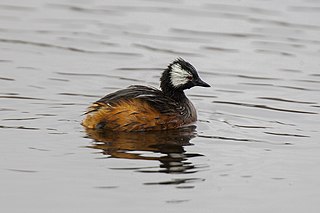| Tricolored grebe | |
|---|---|
| Scientific classification | |
| Domain: | Eukaryota |
| Kingdom: | Animalia |
| Phylum: | Chordata |
| Class: | Aves |
| Order: | Podicipediformes |
| Family: | Podicipedidae |
| Genus: | Tachybaptus |
| Species: | T. tricolor |
| Binomial name | |
| Tachybaptus tricolor (Gray, GR, 1861) | |
| Synonyms | |
Tachybaptus ruficollis tricolor | |
The tricolored grebe (Tachybaptus tricolor) is a bird in the family Podicipedidae sometimes considered conspecific with the little grebe Tachybaptus ruficollis. It is native to maritime Southeast Asia and northern parts of Australasia. [1] [2] The IOC treats it as a distinct species; not all other taxonomic authorities do so, some still consider it conspecific with little grebe.
It is in some respects intermediate between little grebe which occurs to its north in Asia, and Australasian grebe T. novaehollandiae which occurs to its south, but also has some distinct characters of its own, notably the dark blackish-grey underparts plumage (both T. ruficollis and T. novaehollandiae have a pale greyish-white belly). Its rufous cheeks and throat are nearly as extensive as in T. ruficollis (lacking the extensive black throat of T. novaehollandiae), but in bill morphology, it is closer to T. novaehollandiae. [3]
Its range overlaps with T. novaehollandiae in Java and parts of New Guinea. [1] [2]






